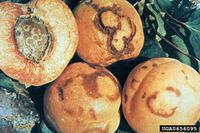Plum pox virus
| Literature database |
|---|
| 440 articles sorted by: |
| • year (descending) |
| • research topics |
| • countries/regions |
| • host plants |

Source: Biologische Bundesanstalt für Land- und Forstwirtschaft - IPM Images
Plum pox virus (PPV) - (sharka disease)
The virus causes severe economic losses on Prunus species in many countries, particularly on plum, peach and apricot. It is one of the most destructive viruses in stone fruit trees. The disease was first described from Bulgaria in 1932 and appears to have spread from there to other parts of Europe, to the Americas and to other regions. Eradication has been (is) attempted in several regions and it is still a quarantine disease in some countries. The symptoms range from chlorotic stains on the leaves to discolorations, necrotic lesions and deformations on the fruits.
| Vernacular names | |
|---|---|
| • Deutsch: | Scharka-Krankheit |
| • English: | sharka disease |
| • Español: | virus de la peca del ciruelo |
| • Français: | virus de la sharka du prunier variole du prunier |
The virus is transmitted through aphids in a non-persistent manner, e.g. by Aphis fabae or Myzus persicae. Seed transmission appears to be also possible. Long distance spread occurs through infected plant material. The disease is managed by sanitation, use of disease-free planting material and resistant cultivars.
Eight strains or groups of the virus been described, based on molecular differences (D, M, Rec, EA, C, W, T, CR). These strains show differences in their host range, transmission mechanisms and geographical distribution. Plum pox virus has long filamentous particles, about 700-800 nm long with a linear single stranded RNA genome. The RNA translates into a large polyprotein which is proteolytically transformed into at least 10 final products.
For a reviews see Garcia et al. (2014), Dallot et al. (2015) and Rodamilans et al. (2020).
- Other images of Plum pox virus (IPM Images - click to enlarge)




